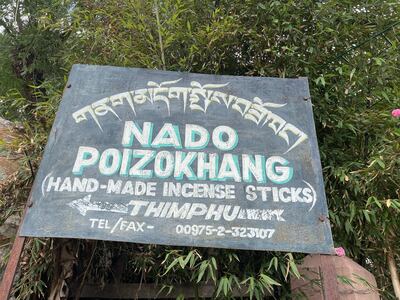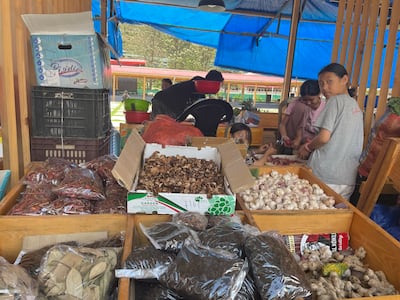An intriguing check-in ceremony greets me at the Bhutan Spirit Sanctuary, a stunning Himalayan resort nestled in Neyphu Valley, Paro, that helps guests find a balance between body, mind and spirit.
After entering the property’s dramatic golden gates, I’m invited to a small shrine for a puja ceremony. I light a butter lamp, and am then handed an incense stick (called a poe in Bhutanese) to burn and “invite good energy for my stay”. As the incense’s fragrance and smoke suffuse the air, I find the ritual undeniably relaxing, especially after a long, bumpy ride through the mountains.
In my suite I discover more scented wands, which work as room fresheners, relaxants and pest control in the Himalayan kingdom. And effectively too, I light one incense stick each night and find it acts like a balm, easing me into restful slumber.

Intrigued, I ask the resident therapist about the effect of incense, and she explains that it's an effective sleep aid which “helps the brain to increase the production of serotonin, the feel-good hormone that promotes healing and happiness”.
“We also use it in aromatherapy to calm the mind and unlock the energy channels to release internal bliss,” she says.
Little did I know that incense would become a leitmotif throughout my five-day stay in the small landlocked country in the eastern Himalayas.

Highly sought after in homes, shrines and monasteries, these aromatic sticks and powders are used for everything from meditation to devotion, healing, purification and relaxation. Their use as a fumigant is also evident from plumes of smoke rising from huts in the countryside every evening when locals burn them to ward off pests.
At every shrine, monastery or dzong (fortress) I visited in three cities – Thimphu, Paro and Punakha – monks burning incense in specially designed censers and incense stick holders were a ubiquitous sight. Some, with their shaved heads buried deep in their prayer books, had a smoking wand by their side.
“The Buddhist ritual of offering fragrance (gandhapuja) and the ancient Bon smoke offering (sang), has a deep cultural and religious significance for us,” an elderly monk at Punakha Dzong says.
“Incense smoke is invested with blessings of powerful mantras. It is used for cleansing and purification which helps in warding off evil spirits and bringing good luck.“

Intrigued by the fascinating subculture of incense, I booked a tour at Bhutan’s most famous incense-making workshop, Nado Poizokhang.
Set in the heart of Thimphu, it is the oldest and largest of its kind and produces incense sticks and powders that are used in homes and monasteries and also exported to many countries. Even Bhutan’s King Jigme Khesar Namgyel Wangchuck requests incense from the family-run enterprise to burn in the royal palace, I’m informed.
For all its fame, however, the workshop’s facade is nondescript and easy to miss, with only a tiny board announcing its presence. Inside, however, it is a hive of activity, with men and women of various ages working on different stages of incense production at their work stations. Some are smiling and chatting with their colleagues, somewhat leavening the serious atmosphere.

Observing my interest, a supervisor offers to take me around for a tour to explain the production process. He says that although simple to look at, incense making requires a lot of hard work and precision, not to mention a cornucopia of ingredients. These include medicinal herbs, dried spices, botanicals, tree barks, boughs of juniper, jatamansi flowers native to the Himalayas, sandalwood, clove, cardamom, saffron and nutmeg.
“The entire process is based on a secret recipe from the Mindrolling Tibetan Buddhist Monastery in India, which is more than 300 years old,” my guide explains as I pick up a wand to inhale its perfume. “Many of these ingredients are foraged and gathered by yak herders from high-altitude forests in the month after the Blessed Rainy Day holiday, Thruebab, which signals monsoon-end. This is when the foliage, nourished by the rain, is most fragrant.”
The production process begins by grinding all the ingredients into a fine powder, they are then mixed with water, sugar and honey. This mix goes into a big vat where it ferments for a week. At this stage, tshe (bark beetle) is added as an adhesive after which the contents are mixed vigorously before being put through the presser to make incense sticks.
The final stage involves the sticks being straightened, cut into various sizes, and dried in the shade for four to five days.
“Everything is done by hand and all the ingredients we use are organic and pure. The incense is hand rolled and sun dried, using traditional methods that go back generations. Each ingredient has unique properties and there’s a reason behind its inclusion in the recipe,” the supervisor adds.

For example, juniper, a fragrant tree that grows in Bhutan’s alpine forests, has a sweet and woody aroma and is believed to have medicinal properties. Similarly, agarwood, also known as oud, is a dark resinous wood that is highly prized for its herbal qualities. “The incense’s pure ingredients also help heighten awareness during meditation. They help take one closer to God,” they add, as the tour comes to an end.
With these words echoing in my mind, I pick up a few packets of Nado Poizokhang’s magical wands to take with me. Back home, every time I unroll my yoga mat to to meditate, I light up one scented stick for the session. They help me relax and focus on all things spiritual, transporting me to Bhutan’s beatific landscapes.
